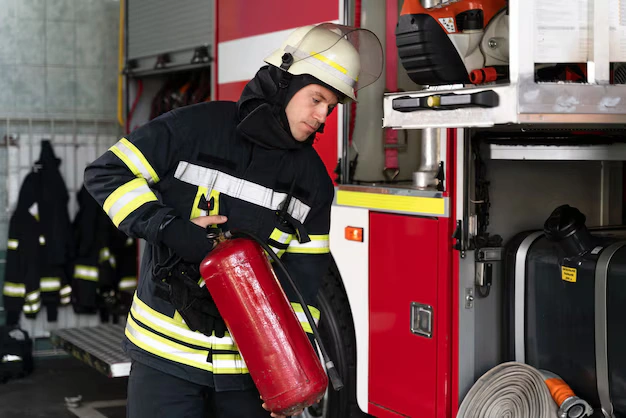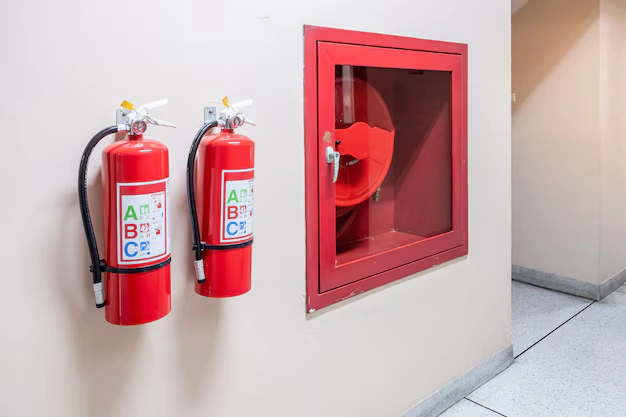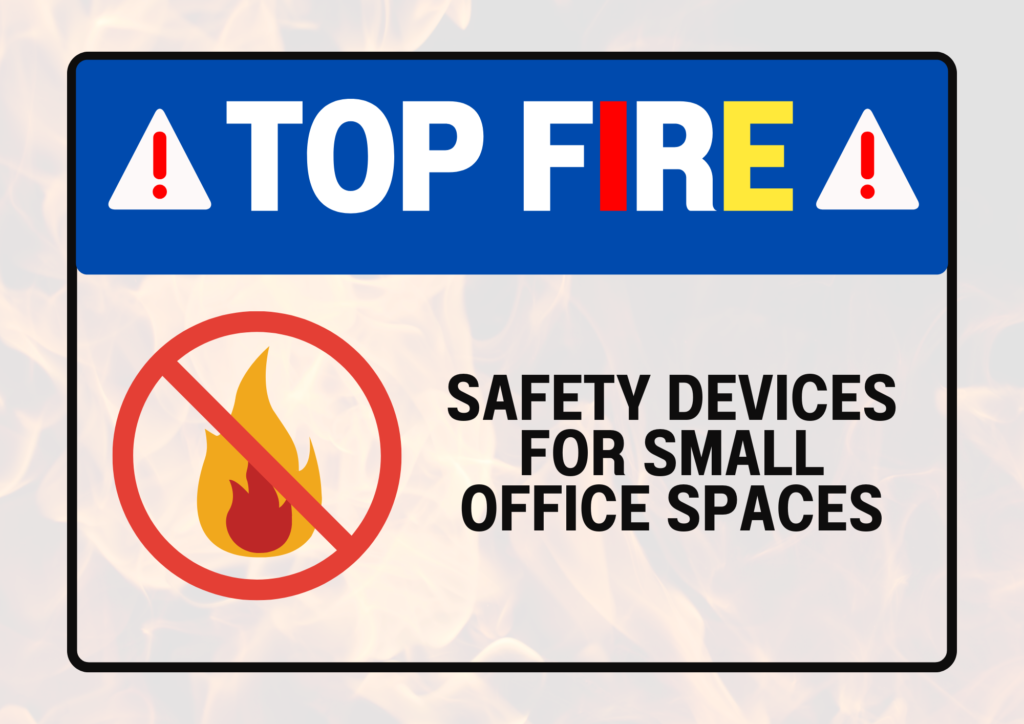One of the most important considerations for a small office is fire safety. While a fire in an industrial home is an unfortunate result, it can easily lead to the spread and damage to the leases in the environment due to a flame. However, there are various safety devices to protect from fire and to create a safer work environment. These appliances, if installed and maintained correctly, can be vital in the line of defense in an emergency. In this post, we will cover the most important fire safety devices all small office owners should have to reduce fire hazards and protect their employees.
1. Fire Extinguishers
Importance of Fire Extinguishers
In any office, fire extinguishers are one of the simplest yet essential fire safety tools. They can help contain small fires before they spread into larger, feral blazes. You should also make sure that fire extinguishers are properly placed.

Types of Fire Extinguishers
- ABC Extinguishers: These are the multi-purpose extinguishers appropriate for most office fires, such as those involving paper or wood, electrical damage, and certain liquids.
- CO₂ Extinguishers: These are best for electrical fires since they don’t leave any residue behind.
- Water and Foam Extinguishers: Can be used for paper, cloth and trash fires but should not be used on electrical fires or flammable liquids.
Placement
Assemble fire extinguishers close to fire-risk locations, like kitchens, electrical rooms and storage areas. It should be easy to find and clearly marked.
2. Smoke Detectors
Why Smoke Detectors Are Essential
One of the critical early warning systems for fire safety is smoke detectors. They sense smoke in the air and sound an alarm as a warning to employees of possible danger. With a small office, these detectors can alert people to evacuate before the fire becomes out of control, and it can save lives.
How Smoke Detectors Work
Smoke detectors use sensors to detect smoke particles in the air. When the concentration of smoke attains a minimum threshold, it triggers the alarm. The two main types of smoke detectors are
- Ionization smoke detectors: These are more responsive to flames.
- Photoelectric smoke detectors: These are more sensitive to slow, smoldering fires.
Placement
Place smoke detectors on the ceiling in hallways, near exit routes, and in high-fire-risk areas. You should test them every month to make sure they are working properly.
3. Fire Alarm Systems
The Role of Fire Alarm Systems
A fire alarm system is a step up from a smoke detector, typically wired into a system of networked sensors run throughout the office. It produces a loud and prominent alarm and commonly connects with other safety devices, like sprinklers, to control fire hazards.
Modern Fire Alarm Systems Features
- Automated Monitoring: Some fire alarm systems automatically contact the local authorities or fire department in case of an emergency.
- Remote Access: We are having them set up so managers or business owners can check the system from their smartphones or computers.
- Voice Alerts: Some of the latest systems give out voice alerts, which are often a lot more descriptive than just an old alarm and are also more audible in bigger offices.
Why It’s Important
Such systems can guarantee that once a fire is detected, the entire office is alerted as soon as possible. In many large or multi-floor office buildings, more advanced alarm systems and protocols are in place to ensure everyone is able to evacuate.
4. Fire Sprinkler Systems
The Role of Fire Sprinkler Systems
Fire sprinklers are the most effective fire safety systems. It can douse a fire in a matter of minutes and also stop it from spreading. They activate when the ambient temperature close to the sprinkler hits a specific point, usually roughly 155°F (68°C).

Advantages of Fire Sprinkler Systems
- Early Activation: Sprinklers activate quickly, often before fire departments can arrive. This speed can help limit property destruction.
- Responsive: Their duty is to protect and secure your property and respond whenever there is a risk.
Where to Install Fire Sprinklers
All areas of the office must have sprinkler systems installed, especially in high-risk areas such as kitchens, server rooms, and storage areas. They are typically mandated in commercial buildings by local fire codes.
5. Fire Blankets
What Are Fire Blankets?
When it comes to putting out small fires, fire blankets are a straightforward but handy tool. They tend to be made out of tightly woven fire-retardant cloth, like fiberglass or wool, and are designed to be wrapped around a person or be placed on top of a small fire in an effort to extinguish it.
Uses of Fire Blankets
- Fires in Small Kitchens: If you want to be prepared for kitchen-related fires, such as those that occur with cooking oils or fats, fire blankets are ideal.
- Individual Defense: When a garment ignites, a fire blanket can protect the person and extinguish the flames.
- Quenching small fires: They can be used to smother small fires in furniture or electrical equipment.
Placement
Fire blankets should be readily available in kitchens, as well as near cooking areas and in any high-risk area of the office. Make sure they’re stored somewhere everyone can access quickly in an emergency.
6. Fire Exit Signs and Emergency Lighting
Importance of Fire Exit Signs
These fire exit signs are vital to ensure employees are able to find safe exits in an emergency. In the smoke or dark, clear, illuminated signs guide people to safety.
Why Emergency Lighting Is Necessary
Emergency lighting is needed in the event of a power failure so employees can safely exit the building during a fire. It has particular necessity in large offices or offices with a complicated layout.
Placement
- Exit Signs: Should be near all exit routes and stairwells. They should be bright enough to be visible through smoke and in the event of a power failure.
- Ensure Emergency Lighting: Providing emergency lighting will help illuminate exit routes, stairwells and hallways for safe evacuation.
7. Fire Door Closures
How Fire Doors Help
We do not need to tell you the importance of keeping your firm a fire-free zone. They’re especially useful for larger office spaces or multi-floor buildings. These doors are usually constructed from fireproof materials and have automatic closers fitted.
Benefits of Fire Doors
- Containment: Fire doors are designed to stop or slow down the spread of fire and smoke, allowing employees to evacuate.
- Compliance: Fire doors are often a legal requirement in commercial buildings across various fields.
- Safety: Escape routes must be protected by fire doors to help ensure that escape routes stay passable during a fire.
Regular Checks
Ensure that fire doors are not blocked or propped open, which defeats their purpose. They should shut automatically and latch tight.
8. Fire Safety Plans and Training
Creating a Fire Safety Plan
A detailed fire safety plan describes what employees should do in the case of a fire. This means communicating the insert details they would need to carry out their job.

Fire Drills and Employee Training
Regular fire drills are a must to ensure that employees know about how to respond in case of a fire. Hold drills at least biannually to review evacuation plans and ensure that employees recognize the locations of fire safety devices.
Ongoing Education
Regular training on fire safety will teach employees how to use fire extinguishers, fire blankets, and other safety devices correctly. It also serves as a reminder about following safety protocols.
Conclusion
Fire safety should be the main priority in a small office. Providing proper fire safety equipment, from fire extinguishers to smoke detectors, in your office and training employees to know how to prepare for emergencies can sensibly mitigate the threat of disaster from a fire breaking out. By taking these safety precautions, you will prevent your employees from an unsafe work environment. Don’t wait for a fire emergency to be ill-prepared.
FAQs
How often do fire extinguishers need to be inspected?
Fire extinguishers must be checked monthly for any signs of damage. It should be professionally maintained annually.
If I have a small office, do I need a fire alarm system?
Yes, fire alarm systems are a must-have in small offices.
What are the guidelines for properly maintaining fire extinguishers?
Check fire extinguishers (for pressure, damage and workability) regularly. Have these professionally serviced once a year so they can go to work for you!
Does a small office have to have fire sprinklers?
Fire sprinklers might be necessary based on local fire codes as well as the size of the workplace. They are one of the most effective means of containing fires and limiting damage.
If you have used your fire extinguisher, what should I do?
Have a non-exposed fire extinguisher immediately ready for the next emergency.


